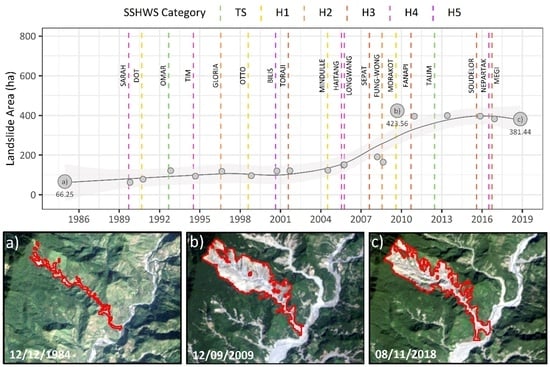Mapping and Analyzing the Evolution of the Butangbunasi Landslide Using Landsat Time Series with Respect to Heavy Rainfall Events during Typhoons
Abstract
1. Introduction
2. Materials and Methods
2.1. Study Area
2.2. Data
2.2.1. Optical Satellite Data
2.2.2. Typhoon and Rainfall Data
2.3. Semi-Automated Landslide Mapping
2.4. Accuracy Assessment of OBIA Results
2.5. Analysis of Rainfall Data during Typhoon Events
2.6. Correlation between the Change in Landslide Area and Rainfall
3. Results
3.1. Semi-Automated Mapping Results
3.2. Comparison of OBIA Results with Visual Interpretation
3.3. Rainfall Data Analysis for Each Typhoon Event
3.4. Relation between Landslide Area Change and Rainfall-Derived Parameters during Typhoon Events
4. Discussion
5. Conclusions
Author Contributions
Funding
Acknowledgments
Conflicts of Interest
References
- Jang, W.; Chun, H.Y. The effects of topography on the evolution of typhoon saomai (2006) under the influence of tropical storm bopha (2006). Mon. Weather Rev. 2013, 141, 468–489. [Google Scholar] [CrossRef]
- Wu, C.-C.; Kuo, Y.-H. Typhoons Affecting Taiwan: Current Understanding and Future Challenges. Bull. Am. Meteorol. Soc. 1999, 80, 67–80. [Google Scholar] [CrossRef]
- Chen, C.J.; Lee, T.Y.; Chang, C.M.; Lee, J.Y. Assessing typhoon damages to Taiwan in the recent decade: Return period analysis and loss prediction. Nat. Hazards 2018, 91, 759–783. [Google Scholar] [CrossRef]
- Liang, A.T.Y.; Oey, L.; Huang, S.; Chou, S. Long-term trends of typhoon-induced rainfall over Taiwan: In situ evidence of poleward shift of typhoons in western North Pacific in recent decades. J. Geophys. Res. 2017, 122, 2750–2765. [Google Scholar] [CrossRef]
- Chang, C.W.; Lin, P.S.; Tsai, C.L. Estimation of sediment volume of debris flow caused by extreme rainfall in Taiwan. Eng. Geol. 2011, 123, 83–90. [Google Scholar] [CrossRef]
- Chen, J.-M.; Li, T.; Shih, C.-F. Tropical Cyclone- and Monsoon-Induced Rainfall Variability in Taiwan. J. Clim. 2010, 23, 4107–4120. [Google Scholar] [CrossRef]
- Tu, J.Y.; Chou, C. Changes in precipitation frequency and intensity in the vicinity of Taiwan: Typhoon versus non-typhoon events. Environ. Res. Lett. 2013, 8, 014023. [Google Scholar] [CrossRef]
- Chen, C.-W.; Oguchi, T.; Hayakawa, Y.S.; Saito, H.; Chen, H.; Yuichi, I.; Hayakawa, S.; Saito, H.; Chen, H. Relationship between landslide size and rainfall conditions in Taiwan. Landslides 2017, 14, 1235–1240. [Google Scholar] [CrossRef]
- Chen, C.-W.; Oguchi, T.; Hayakawa, Y.S.; Saito, H.; Chen, H.; Lin, G.-W.; Wei, L.-W.; Chao, Y.-C. Sediment yield during typhoon events in relation to landslides, rainfall, and catchment areas in Taiwan. Geomorphology 2018, 303, 540–548. [Google Scholar] [CrossRef]
- Alexander, D. Vulnerability to landslides. In Landslide Hazard and Risk; Glade, T., Anderson, M., Crozier, M.J., Eds.; John Wiley & Sons Ltd.: Hoboken, NJ, USA; Chichester, UK, 2005; pp. 175–198. [Google Scholar] [CrossRef]
- Piciullo, L.; Calvello, M.; Cepeda, J.M. Territorial early warning systems for rainfall-induced landslides. Earth-Sci. Rev. 2018, 179, 228–247. [Google Scholar] [CrossRef]
- Petley, D. Global patterns of loss of life from landslides. Geology 2012, 40, 927–930. [Google Scholar] [CrossRef]
- Sanchez, C.; Lee, T.-S.; Young, S.; Batts, D.; Benjamin, J.; Malilay, J. Risk factors for mortality during the 2002 landslides in Chuuk, Federated States of Micronesia. Disasters 2009, 33, 705–720. [Google Scholar] [CrossRef] [PubMed]
- Tsai, F.; Hwang, J.H.; Chen, L.C.; Lin, T.H. Post-disaster assessment of landslides in southern Taiwan after 2009 Typhoon Morakot using remote sensing and spatial analysis. Nat. Hazards Earth Syst. Sci. 2010, 10, 2179–2190. [Google Scholar] [CrossRef]
- Guthrie, R.H.; Evans, S.G. Work, persistence, and formative events: The geomorphic impact of landslides. Geomorphology 2007, 88, 266–275. [Google Scholar] [CrossRef]
- Chen, S.-C.; Huang, B.-T. Non-structural mitigation programs for sediment-related disasters after the Chichi Earthquake in Taiwan. J. Mt. Sci. 2010, 7, 291–300. [Google Scholar] [CrossRef]
- Liu, C.-N.; Dong, J.-J.; Chen, C.-J.; Lee, W.-F. Typical landslides and related mechanisms in Ali Mountain highway induced by typhoon Morakot: Perspectives from engineering geology. Landslides 2012, 9, 239–254. [Google Scholar] [CrossRef]
- Chen, S.C.; Hsu, C.L.; Wu, T.Y.; Chou, H.T.; Cui, P. Landslide dams induced by typhoon Morakot and risk assessment. In Proceedings of the 5th International Conference on Debris-Flow Hazards Mitigation: Mechanics, Prediction and Assessment, Padua, Italy, 14–17 June 2011; pp. 653–660. [Google Scholar]
- Li, H.-C.; Hsieh, L.-S.; Chen, L.-C.; Lin, L.-Y.; Li, W.-S. Disaster investigation and analysis of Typhoon Morakot. J. Chin. Inst. Eng. 2014, 37, 558–569. [Google Scholar] [CrossRef]
- Prasicek, G.; Hölbling, D.; Argentin, A.-L.; Friedl, B. Detection and analysis of River course changes and lake formation--The RiCoLa Project. In Proceedings of the EGU General Assembly Conference Abstracts, Vienna, Austria, 23–28 April 2017; Volume 20, p. 7768. [Google Scholar]
- Hovius, N.; Stark, C.P.; Hao-Tsu, C.; Jiun-Chuan, L. Supply and removal of sediment in a landslide-dominated mountain belt: Central Range, Taiwan. J. Geol. 2000, 108, 73–89. [Google Scholar] [CrossRef]
- Dadson, S.J.; Hovius, N.; Chen, H.; Dade, W.B.; Hsieh, M.-L.; Willett, S.D.; Hu, J.-C.; Horng, M.-J.; Chen, M.-C.; Stark, C.P.; et al. Links between erosion, runoff variability and seismicity in the Taiwan orogen. Nature 2003, 426, 648. [Google Scholar] [CrossRef]
- Wu, C.-C.; Ming-Jen, Y. Preface to the Special Issue on “Typhoon Morakot (2009): Observation, Modeling, and Forecasting”. TAO Terr. Atmos. Ocean. Sci. 2011, 22, I. [Google Scholar] [CrossRef][Green Version]
- Chen, S.; Hong, Y.; Cao, Q.; Kirstetter, P.-E.; Gourley, J.J.; Qi, Y.; Zhang, J.; Howard, K.; Hu, J.; Wang, J. Performance evaluation of radar and satellite rainfalls for Typhoon Morakot over Taiwan: Are remote-sensing products ready for gauge denial scenario of extreme events? J. Hydrol. 2013, 506, 4–13. [Google Scholar] [CrossRef]
- Wu, L.; Liang, J.; Wu, C.-C. Monsoonal influence on Typhoon Morakot (2009). Part I: Observational analysis. J. Atmos. Sci. 2011, 68, 2208–2221. [Google Scholar] [CrossRef]
- Lee, H.S.; Yamashita, T.; Hsu, J.R.C.; Ding, F. Integrated modeling of the dynamic meteorological and sea surface conditions during the passage of Typhoon Morakot. Dyn. Atmos. Ocean. 2013, 59, 1–23. [Google Scholar] [CrossRef]
- Tsou, C.-Y.; Feng, Z.-Y.; Chigira, M. Catastrophic landslide induced by typhoon Morakot, Shiaolin, Taiwan. Geomorphology 2011, 127, 166–178. [Google Scholar] [CrossRef]
- Wu, C.-H.; Chen, S.-C.; Feng, Z.-Y. Formation, failure, and consequences of the Xiaolin landslide dam, triggered by extreme rainfall from Typhoon Morakot, Taiwan. Landslides 2014, 11, 357–367. [Google Scholar] [CrossRef]
- Lin, C.H.; Lin, M.L. Evolution of the large landslide induced by Typhoon Morakot: A case study in the Butangbunasi River, southern Taiwan using the discrete element method. Eng. Geol. 2015, 197, 172–187. [Google Scholar] [CrossRef]
- Lo, C.M.; Weng, M.C.; Lin, M.L.; Lee, S.M.; Lee, K.C. Landscape evolution characteristics of large-scale erosion and landslides at the putanpunas stream, Taiwan. Geomat. Nat. Hazards Risk 2018, 9, 175–195. [Google Scholar] [CrossRef]
- Lo, C.M. Evolution of deep-seated landslide at Putanpunas stream, Taiwan. Geomat. Nat. Hazards Risk 2017, 8, 1204–1224. [Google Scholar] [CrossRef]
- Dabiri, Z.; Hölbling, D.; Abad, L.; Prasicek, G.; Argentin, A.-L.; Tsai, T.-T. An Object-Based Approach for Monitoring the Evolution of Landslide-dammed Lakes and Detecting Triggering Landslides in Taiwan. ISPRS Int. Arch. Photogramm. Remote Sens. Spat. Inf. Sci. 2019, XLII-3/W8, 103–108. [Google Scholar] [CrossRef]
- Hölbling, D.; Dabiri, Z.; Tsai, T.T.; Prasicek, G.; Tsui, C.Y.; Schäffer, L.; Argentin, A.-L.M.; Abad, L. Mapping the Evolution of the Butangbunasi Landslide, Taiwan, using Landsat Time Series. In Proceedings of the 27th IUGG General Assembly, Montréal, QC, Canada, 8–18 July 2019. [Google Scholar]
- Capart, H.; Hsu, J.P.C.; Lai, S.Y.J.; Hsieh, M.-L. Formation and decay of a tributary-dammed lake, Laonong River, Taiwan. Water Resour. Res. 2010, 46. [Google Scholar] [CrossRef]
- Cheng, H.-Y. Confluence Morphodynamics with Tributary Influx and Lake Formation: Field Survey and Experiments; National Taiwan University: Taipei, Taiwan, 2011. [Google Scholar] [CrossRef]
- Huang, Y.-R. Assessment of Natural Dam Occurrence Caused by Debris Flow; National Cheng Kung University: Tainan, Taiwan, 2015. [Google Scholar] [CrossRef]
- Hölbling, D.; Betts, H.; Spiekermann, R.; Phillips, C. Identifying Spatio-Temporal Landslide Hotspots on North Island, New Zealand, by Analyzing Historical and Recent Aerial Photography. Geosciences 2016, 6, 48. [Google Scholar] [CrossRef]
- Crosta, G.B.; Frattini, P. Distributed modelling of shallow landslides triggered by intense rainfall. Nat. Hazards Earth Syst. Sci. 2003, 3, 81–93. [Google Scholar] [CrossRef]
- Metternicht, G.; Hurni, L.; Gogu, R. Remote sensing of landslides: An analysis of the potential contribution to geo-spatial systems for hazard assessment in mountainous environments. Remote Sens. Environ. 2005, 98, 284–303. [Google Scholar] [CrossRef]
- Casagli, N.; Cigna, F.; Bianchini, S.; Hölbling, D.; Füreder, P.; Righini, G.; Del Conte, S.; Friedl, B.; Schneiderbauer, S.; Iasio, C.; et al. Landslide mapping and monitoring by using radar and optical remote sensing: Examples from the EC-FP7 project SAFER. Remote Sens. Appl. Soc. Environ. 2016, 4, 92–108. [Google Scholar] [CrossRef]
- Joyce, K.E.; Belliss, S.E.; Samsonov, S.V.; McNeill, S.J.; Glassey, P.J. A review of the status of satellite remote sensing and image processing techniques for mapping natural hazards and disasters. Prog. Phys. Geogr. 2009, 33, 183–207. [Google Scholar] [CrossRef]
- Delaney, K.B.; Evans, S.G. The 2000 Yigong landslide (Tibetan Plateau), rockslide-dammed lake and outburst flood: Review, remote sensing analysis, and process modelling. Geomorphology 2015, 246, 377–393. [Google Scholar] [CrossRef]
- Bozzano, F.; Mazzanti, P.; Perissin, D.; Rocca, A.; De Pari, P.; Discenza, M. Basin scale assessment of landslides geomorphological setting by advanced InSAR analysis. Remote Sens. 2017, 9, 267. [Google Scholar] [CrossRef]
- Fiorucci, F.; Giordan, D.; Santangelo, M.; Dutto, F.; Rossi, M.; Guzzetti, F. Criteria for the optimal selection of remote sensing optical images to map event landslides. Nat. Hazards Earth Syst. Sci. 2018, 18, 405–417. [Google Scholar] [CrossRef]
- Hölbling, D.; Eisank, C.; Albrecht, F.; Vecchiotti, F.; Friedl, B.; Weinke, E.; Kociu, A. Comparing manual and semi-automated landslide mapping based on optical satellite images from different sensors. Geosciences 2017, 7, 37. [Google Scholar] [CrossRef]
- Behling, R.; Roessner, S.; Golovko, D.; Kleinschmit, B. Derivation of long-term spatiotemporal landslide activity—A multi-sensor time series approach. Remote Sens. Environ. 2016, 186, 88–104. [Google Scholar] [CrossRef]
- Lu, P.; Stumpf, A.; Kerle, N.; Casagli, N. Object-oriented change detection for landslide rapid mapping. IEEE Geosci. Remote Sens. Lett. 2011, 8, 701–705. [Google Scholar] [CrossRef]
- Hölbling, D.; Füreder, P.; Antolini, F.; Cigna, F.; Casagli, N.; Lang, S. A Semi-Automated Object-Based Approach for Landslide Detection Validated by Persistent Scatterer Interferometry Measures and Landslide Inventories. Remote Sens. 2012, 4, 1310–1336. [Google Scholar] [CrossRef]
- Hölbling, D.; Friedl, B.; Eisank, C. An object-based approach for semi-automated landslide change detection and attribution of changes to landslide classes in northern Taiwan. Earth Sci. Inform. 2015, 8, 327–335. [Google Scholar] [CrossRef]
- Aksoy, B.; Ercanoglu, M. Landslide identification and classification by object-based image analysis and fuzzy logic: An example from the Azdavay region (Kastamonu, Turkey). Comput. Geosci. 2012, 38, 87–98. [Google Scholar] [CrossRef]
- Martha, T.R.; Kerle, N.; Jetten, V.; van Westen, C.J.; Kumar, K.V. Characterising spectral, spatial and morphometric properties of landslides for semi-automatic detection using object-oriented methods. Geomorphology 2010, 116, 24–36. [Google Scholar] [CrossRef]
- Moosavi, V.; Talebi, A.; Shirmohammadi, B. Producing a landslide inventory map using pixel-based and object-oriented approaches optimized by Taguchi method. Geomorphology 2014, 204, 646–656. [Google Scholar] [CrossRef]
- Eisank, C.; Hölbling, D.; Friedl, B.; Chen, Y.-C.; Chang, K.-T. Expert knowledge for object-based landslide mapping in Taiwan. Southeast. Eur. J. Earth Obs. Geomat. 2014, 3, 347–350. [Google Scholar]
- Barlow, J.; Franklin, S.; Martin, Y. High Spatial Resolution Satellite Imagery, DEM Derivatives, and Image Segmentation for the Detection of Mass Wasting Processes. Photogramm. Eng. Remote Sens. 2006, 72, 687–692. [Google Scholar] [CrossRef]
- Keyport, R.N.; Oommen, T.; Martha, T.R.; Sajinkumar, K.S.; Gierke, J.S. A comparative analysis of pixel- and object-based detection of landslides from very high-resolution images. Int. J. Appl. Earth Obs. Geoinf. 2018, 64, 1–11. [Google Scholar] [CrossRef]
- Lahousse, T.; Chang, K.T.; Lin, Y.H. Landslide mapping with multi-scale object-based image analysis-a case study in the Baichi watershed, Taiwan. Nat. Hazards Earth Syst. Sci. 2011, 11, 2715–2726. [Google Scholar] [CrossRef]
- Plank, S.; Hölbling, D.; Eisank, C.; Friedl, B.; Martinis, S.; Twele, A. Comparing object-based landslide detection methods based on polarimetric SAR and optical satellite imagery—A case study in Taiwan. In Proceedings of the 7th International Workshop on Science and Applications of SAR Polarimetry and Polarimetric Interferometry, POLinSAR, Frascati, Italy, 26–30 January 2015; pp. 1–5. [Google Scholar]
- Rau, J.-Y.; Jhan, J.-P.; Rau, R.-J. Semiautomatic object-oriented landslide recognition scheme from multisensor optical imagery and DEM. IEEE Trans. Geosci. Remote Sens. 2014, 52, 1336–1349. [Google Scholar] [CrossRef]
- Rau, J.-Y.; Jhan, J.P.; Lo, C.F.; Lin, Y.S. Landslide Mapping Using Imagery Acquired By a Fixed-Wing UAV. ISPRS Int. Arch. Photogramm. Remote Sens. Spat. Inf. Sci. 2012, XXXVIII-1, 195–200. [Google Scholar] [CrossRef]
- NOAA (National Oceanic and Atmospheric Administration): Office for Coastal Management Historical Hurricane Tracks. Available online: https://coast.noaa.gov/hurricanes/ (accessed on 25 November 2019).
- Liang, S.; Fang, H.; Chen, M. Atmospheric correction of Landsat ETM+ land surface imagery. I. Methods. IEEE Trans. Geosci. Remote Sens. 2001, 39, 2490–2498. [Google Scholar] [CrossRef]
- Flood, N. Continuity of reflectance data between landsat-7 ETM+ and landsat-8 OLI, for both top-of-atmosphere and surface reflectance: A study in the australian landscape. Remote Sens. 2014, 6, 7952–7970. [Google Scholar] [CrossRef]
- Knapp, K.R.; Kruk, M.C.; Levinson, D.H.; Diamond, H.J.; Neumann, C.J. The international best track archive for climate stewardship (IBTrACS). Bull. Am. Meteorol. Soc. 2010, 91, 363–376. [Google Scholar] [CrossRef]
- CWB (Central Weather Bureau) Typhoon Database. Available online: https://rdc28.cwb.gov.tw/ (accessed on 25 November 2019).
- Funk, C.; Peterson, P.; Landsfeld, M.; Pedreros, D.; Verdin, J.; Shukla, S.; Husak, G.; Rowland, J.; Harrison, L.; Hoell, A.; et al. The climate hazards infrared precipitation with stations—A new environmental record for monitoring extremes. Sci. Data 2015, 2, 150066. [Google Scholar] [CrossRef]
- Retalis, A.; Tymvios, F.; Katsanos, D.; Michaelides, S. Downscaling CHIRPS precipitation data: An artificial neural network modelling approach. Int. J. Remote Sens. 2017, 38, 3943–3959. [Google Scholar] [CrossRef]
- Baatz, M.; Schäpe, A. Multiresolution Segmentation: An optimization approach for high quality multi-scale image segmentation. In Angewandte Geographische Informationsverarbeitung XII; Strobl, J., Blaschke, T., Griesebner, G., Eds.; Wichmann: Berlin/Heidelberg, Germany, 2000; pp. 12–23. [Google Scholar]
- Behling, R.; Roessner, S.; Segl, K.; Kleinschmit, B.; Kaufmann, H. Robust automated image co-registration of optical multi-sensor time series data: Database generation for multi-temporal landslide detection. Remote Sens. 2014, 6, 2572–2600. [Google Scholar] [CrossRef]
- Congalton, R.G. A review of assessing the accuracy of classifications of remotely sensed data. Remote Sens. Environ. 1991, 37, 35–46. [Google Scholar] [CrossRef]
- Mukaka, M.M. Statistics Corner: A guide to appropriate use of Correlation coefficient in medical research. Malawi Med. J. 2012, 24, 69–71. [Google Scholar]
- Weaver, K.F.; Morales, V.C.; Dunn, S.L.; Godde, K.; Weaver, P.F. An Introduction to Statistical Analysis in Research: With Applications in the Biological and Life Sciences; Wiley: Hoboken, NY, USA, 2017; ISBN 9781119301103. [Google Scholar]
- Dahiru, T. p-value, a true test of statistical significance? A cautionary note. Ann. Ibadan Postgrad. Med. 2008, 6, 21–26. [Google Scholar] [CrossRef] [PubMed]
- Costa, H.; Foody, G.M.; Boyd, D.S. Using mixed objects in the training of object-based image classifications. Remote Sens. Environ. 2017. [Google Scholar] [CrossRef]
- Merickel, M.B.; Lundgren, J.C.; Shen, S.S. A spatial processing algorithm to reduce the effects of mixed pixels and increase the separability between classes. Pattern Recognit. 1984. [Google Scholar] [CrossRef]
- Chen, C.-W.; Saito, H.; Oguchi, T. Rainfall intensity–duration conditions for mass movements in Taiwan. Prog. Earth Planet. Sci. 2015, 2, 14. [Google Scholar] [CrossRef]
- Quesada-Román, A.; Fallas-López, B.; Hernández-Espinoza, K.; Stoffel, M.; Ballesteros-Cánovas, J.A. Relationships between earthquakes, hurricanes, and landslides in Costa Rica. Landslides 2019. [Google Scholar] [CrossRef]
- Tao, T.; Chocat, B.; Liu, S.; Xin, K. Uncertainty Analysis of Interpolation Methods in Rainfall Spatial Distribution–A Case of Small Catchment in Lyon. J. Water Resour. Prot. 2009, 1, 136–144. [Google Scholar] [CrossRef]
- Guzzetti, F.; Mondini, A.C.; Cardinali, M.; Fiorucci, F.; Santangelo, M.; Chang, K.-T. Landslide inventory maps: New tools for an old problem. Earth-Sci. Rev. 2012, 112, 42–66. [Google Scholar] [CrossRef]
- Lin, W.T.; Chou, W.C.; Lin, C.Y.; Huang, P.H.; Tsai, J.S. Vegetation recovery monitoring and assessment at landslides caused by earthquake in Central Taiwan. For. Ecol. Manag. 2005. [Google Scholar] [CrossRef]
- Chou, W.-C.; Lin, W.-T.; Lin, C.-Y. Vegetation recovery patterns assessment at landslides caused by catastrophic earthquake: A case study in central Taiwan. Environ. Monit. Assess. 2008, 152, 245. [Google Scholar] [CrossRef]
- Guzzetti, F.; Peruccacci, S.; Rossi, M.; Stark, C.P. Rainfall thresholds for the initiation of landslides in central and southern Europe. Meteorol. Atmos. Phys. 2007, 98, 239–267. [Google Scholar] [CrossRef]
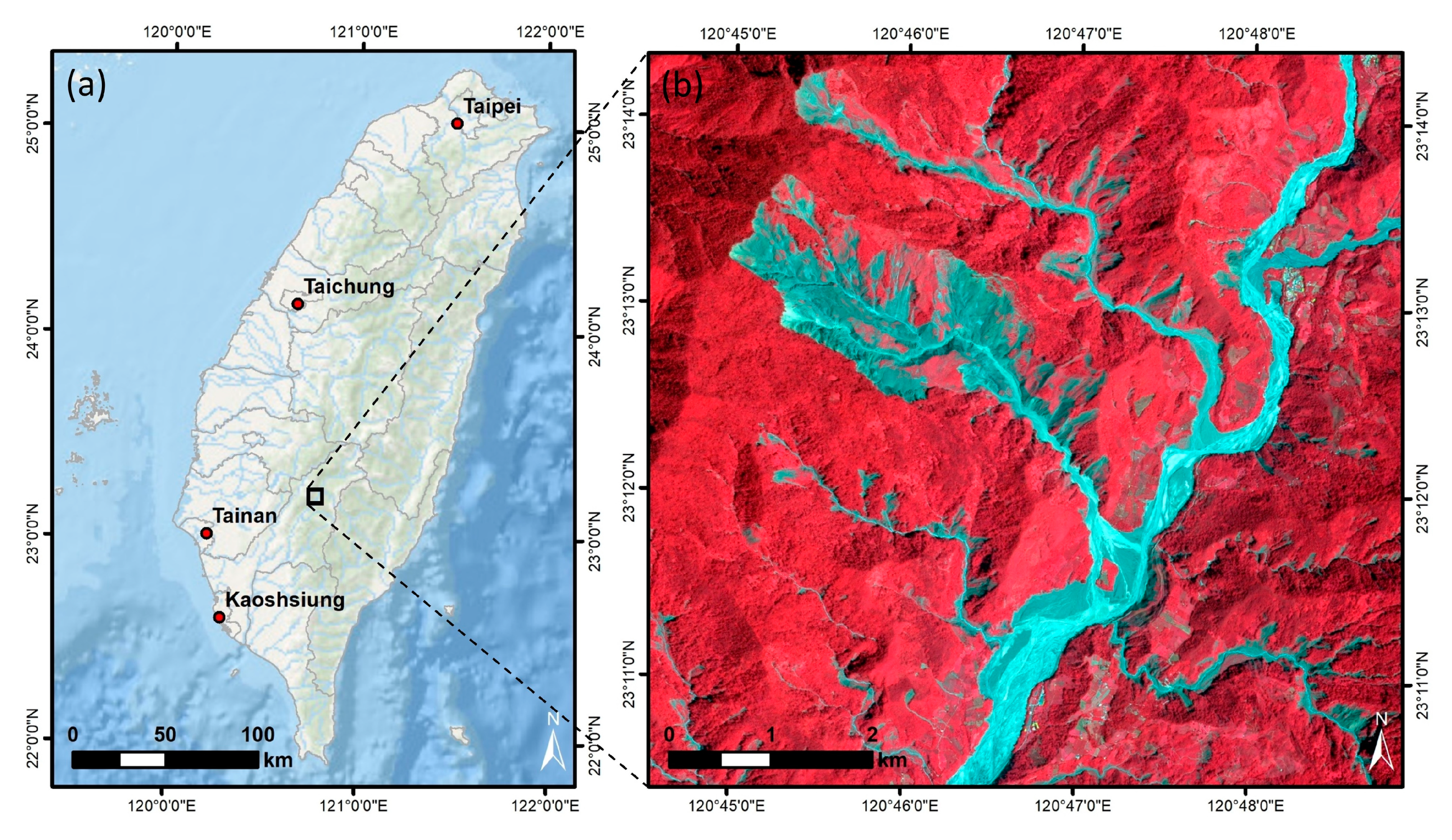
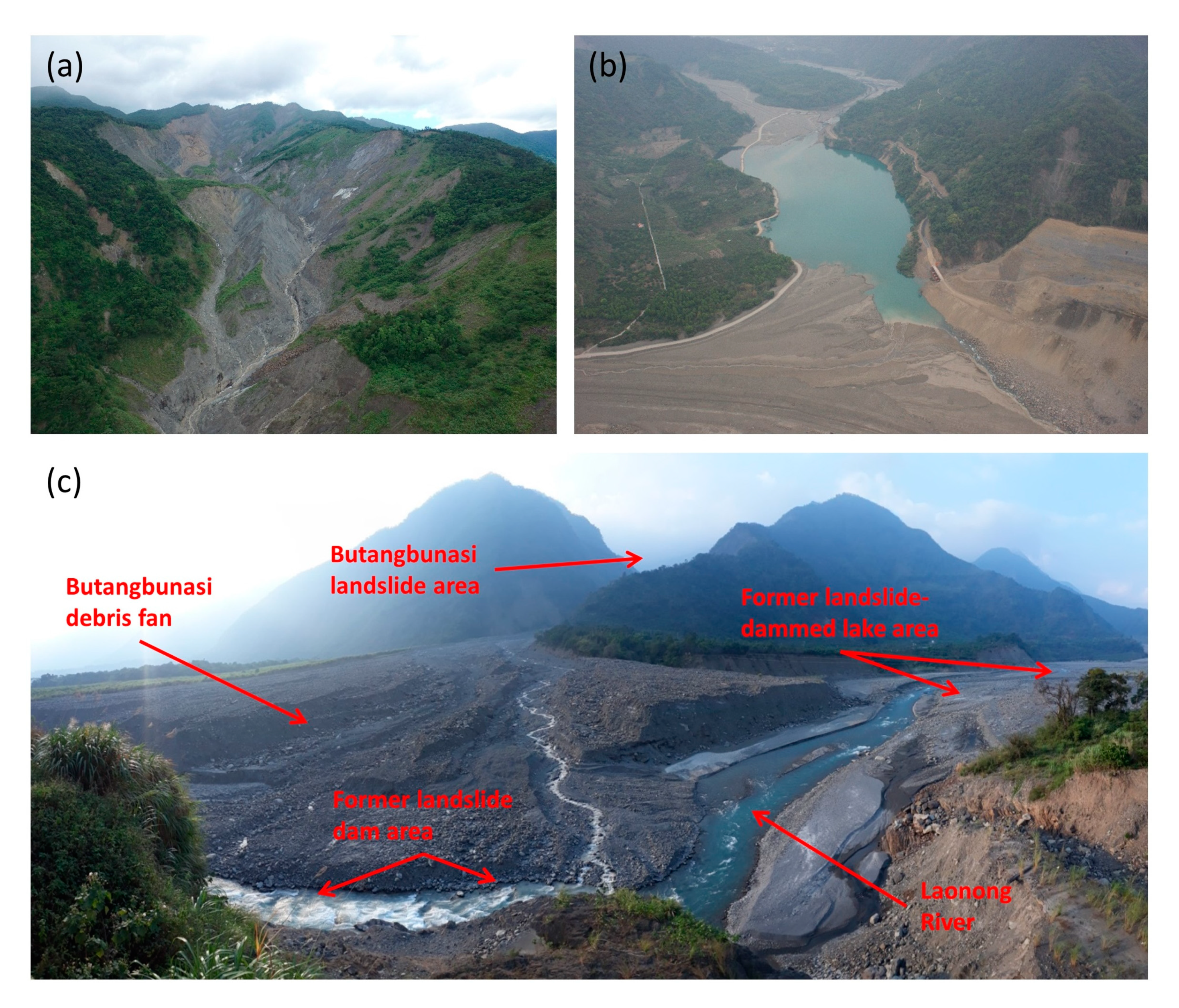
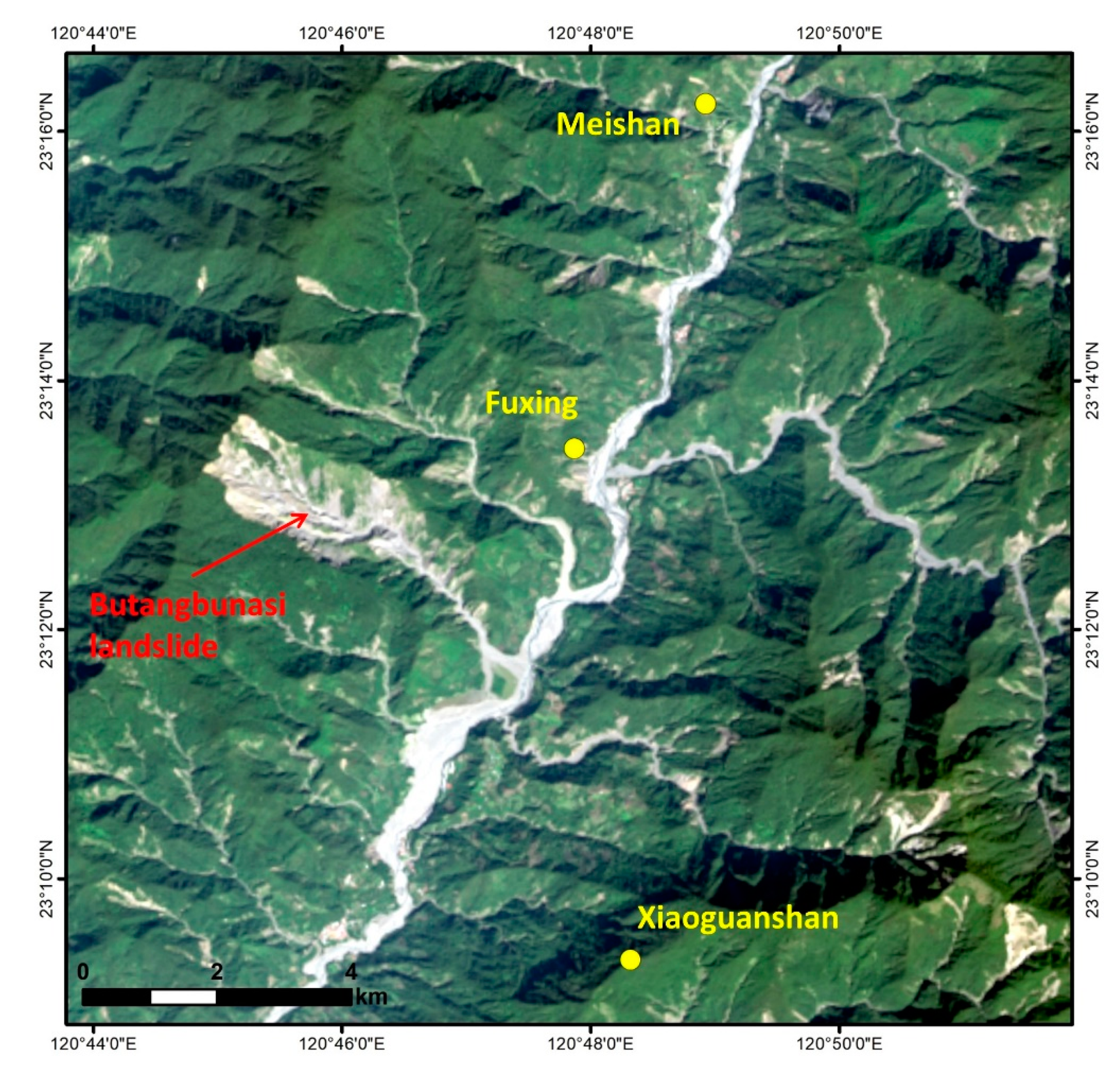
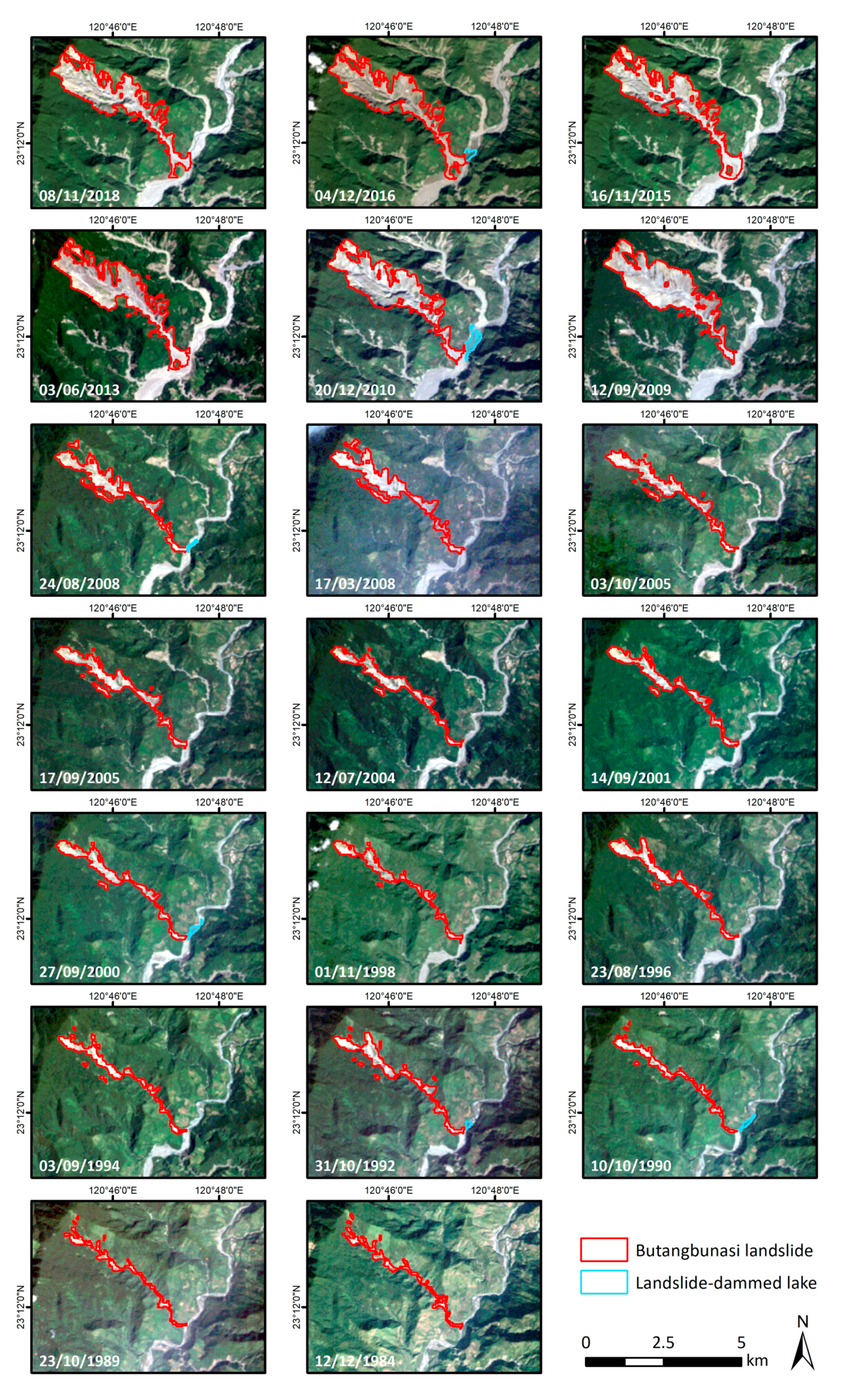
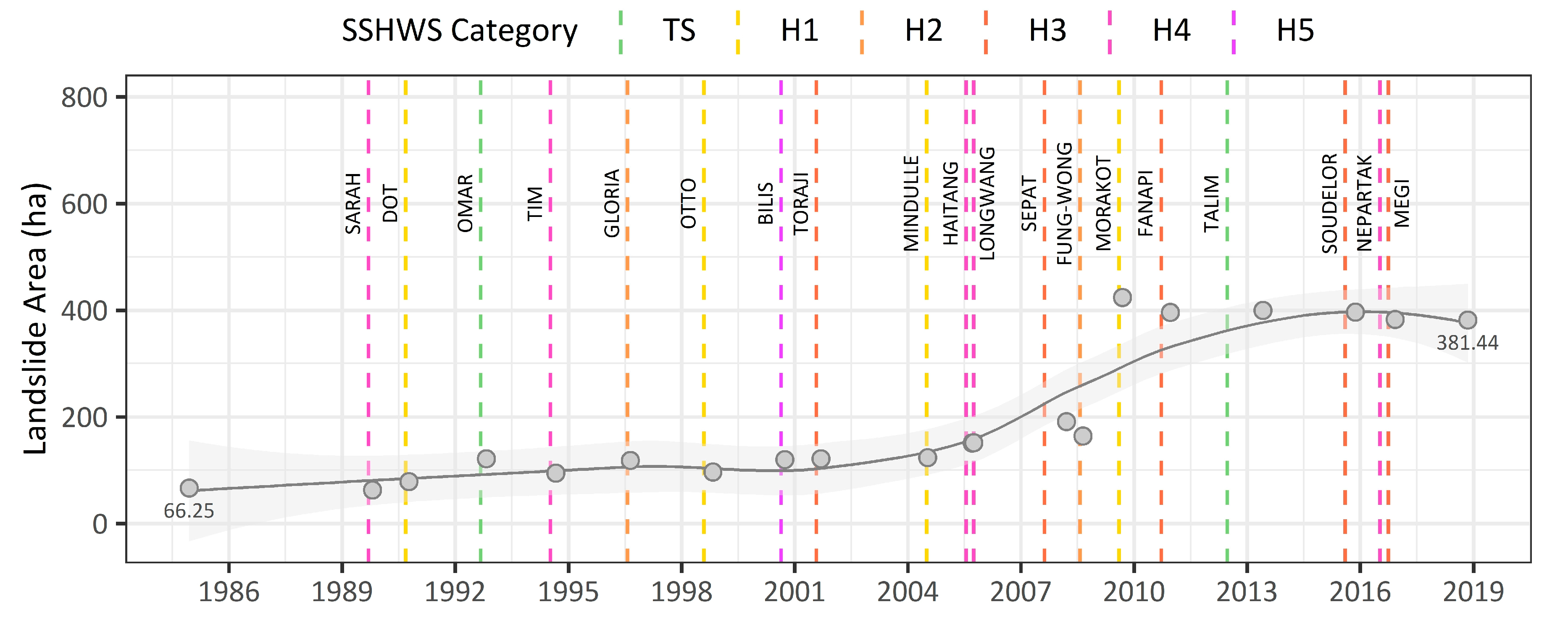
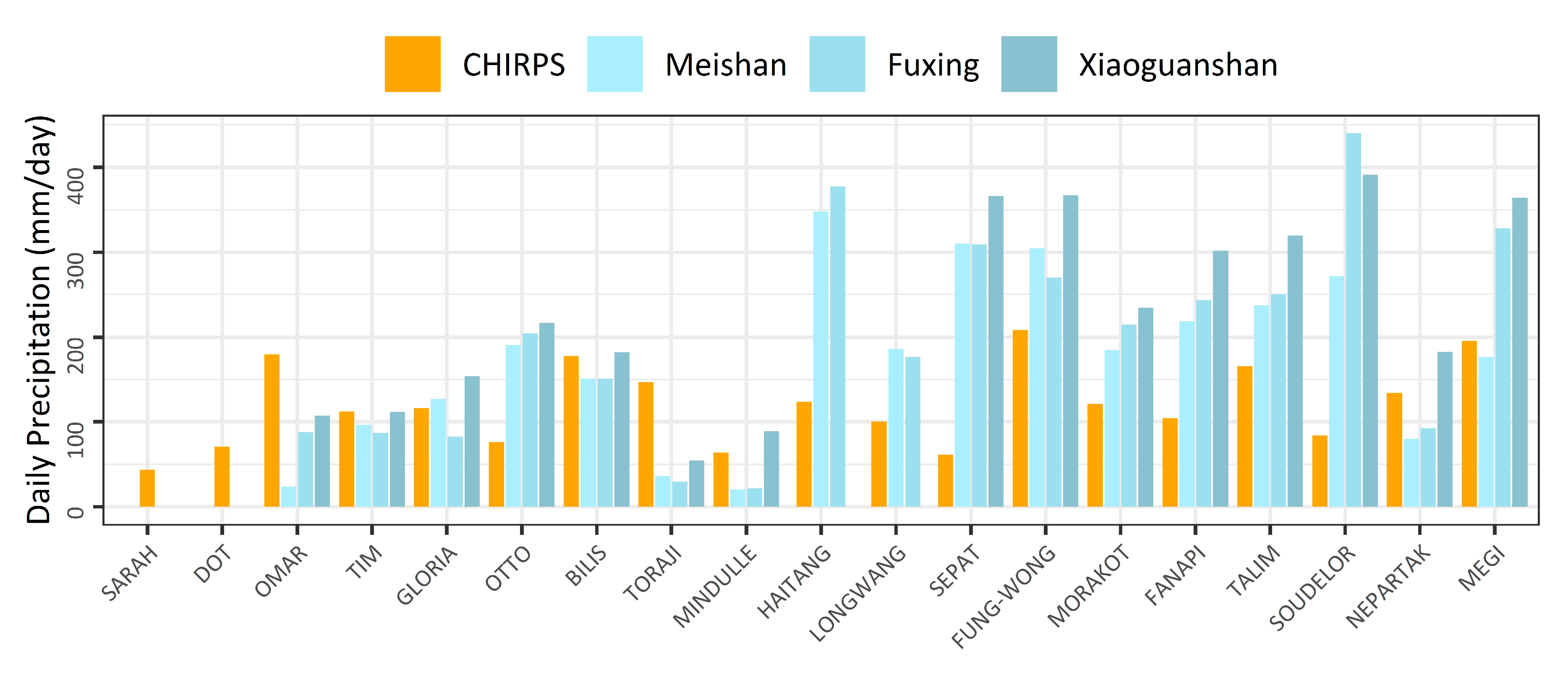
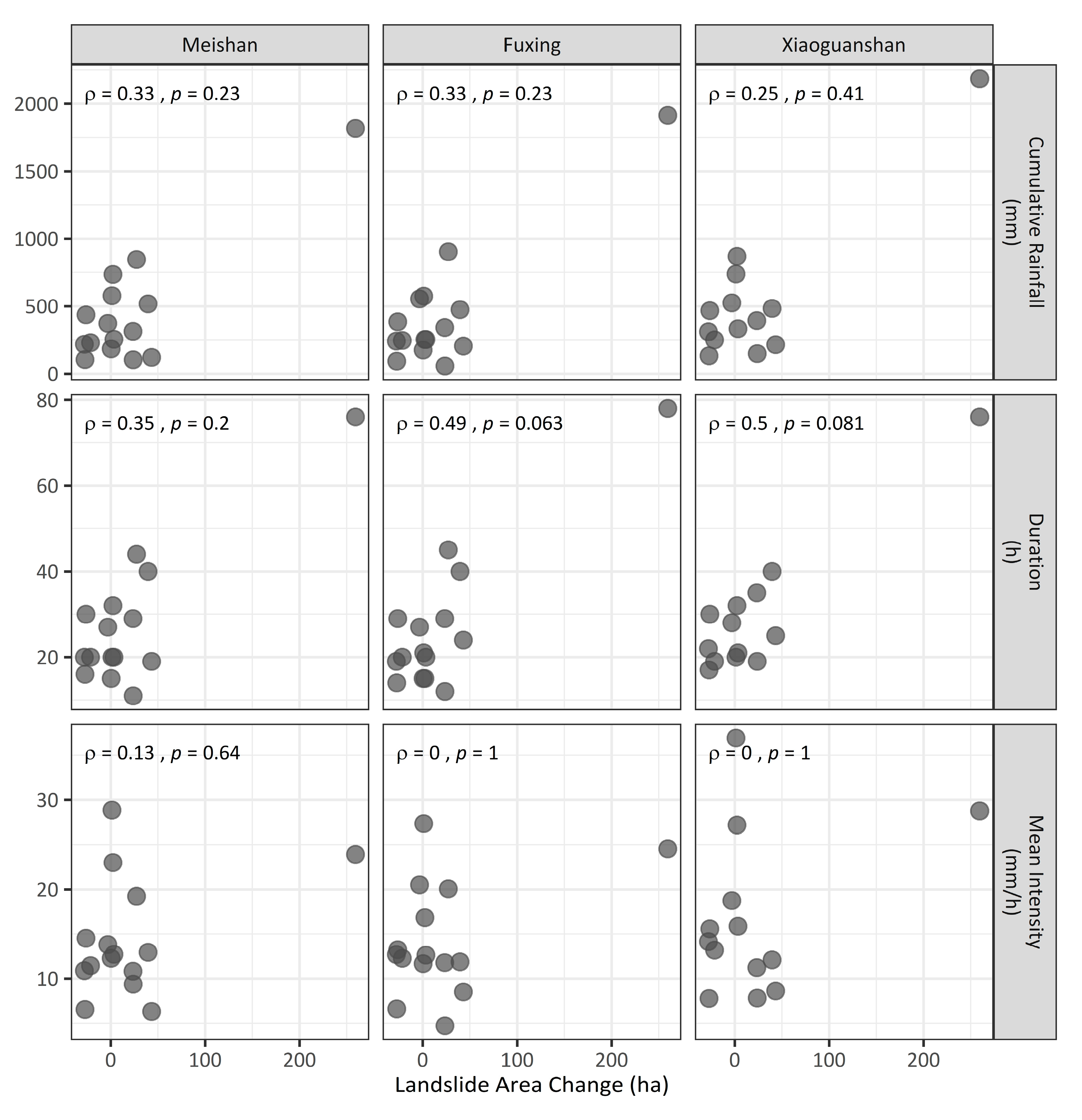
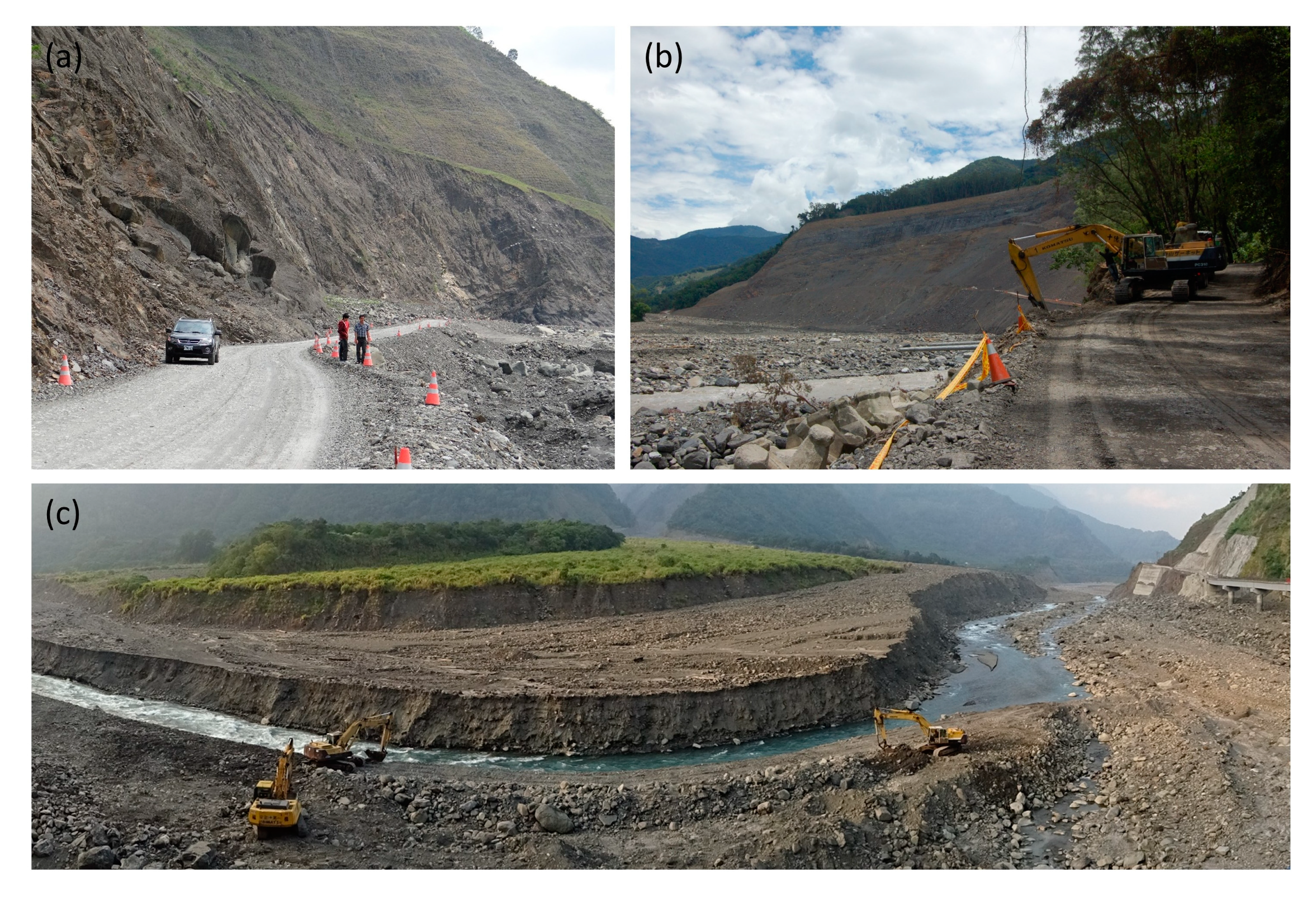
| Sensor | Acquisition Date | Scene ID |
|---|---|---|
| Landsat 8 | 8 November 2018 | LC81170442018312LGN00 |
| Landsat 8 | 4 December 2016 | LC81170442016339LGN01 |
| Landsat 8 | 16 November 2015 | LC81170442015320LGN01 |
| Landsat 8 | 03 June 2013 | LC81170442013154LGN01 |
| Landsat 5 | 20 December 2010 | LT51170442010354BKT00 |
| Landsat 5 | 12 September 2009 | LT51170442009255BKT00 |
| Landsat 5 | 24 August 2008 | LT51170442008237BKT00 |
| Landsat 5 | 17 March 2008 | LT51170442008077BKT00 |
| Landsat 5 | 3 October 2005 | LT51170442005276BJC00 |
| Landsat 5 | 17 September 2005 | LT51170442005260BKT02 |
| Landsat 5 | 12 July 2004 | LT51170442004194BKT02 |
| Landsat 7 | 14 September 2001 | LE71170442001257EDC00 |
| Landsat 7 | 27 September 2000 | LE71170442000271SGS00 |
| Landsat 5 | 1 November 1998 | LT51170441998305BJC00 |
| Landsat 5 | 23 August 1996 | LT51170441996236CLT00 |
| Landsat 5 | 3 September 1994 | LT51170441994246CLT00 |
| Landsat 5 | 31 October 1992 | LT51170441992305BJC00 |
| Landsat 5 | 10 October 1990 | LT51170441990283BJC00 |
| Landsat 5 | 23 October 1989 | LT51170441989296BJC00 |
| Landsat 5 | 12 December 1984 | LT51170441984347HAJ00 |
| Name | Year | Date and Time 1 | Maximum SSHWS Category 2 | SSHWS Category 1 | Distance to Butangbunasi Landslide (km) 1 |
|---|---|---|---|---|---|
| Megi | 2016 | 27 September 2016 12:00 | H3 | H1 | 74 |
| Nepartak | 2016 | 8 July 2016 03:00 | H4 | H1 | 58 |
| Soudelor | 2015 | 8 August 2015 00:00 | H3 | H2 | 78 |
| Talim | 2012 | 20 June 2012 12:00 | TS | TS | 151 |
| Fanapi | 2010 | 19 September 2010 06:00 | H3 | H1 | 16 |
| Morakot | 2009 | 7 August 2009 18:00 | H1 | TS | 108 |
| Fung-Wong | 2008 | 28 July 2008 00:00 | H2 | H2 | 64 |
| Sepat | 2007 | 18 August 2007 00:00 | H3 | H3 | 46 |
| Longwang | 2005 | 2 October 2005 00:00 | H4 | H2 | 85 |
| Haitang | 2005 | 18 July 2005 03:00 | H4 | H3 | 106 |
| Mindulle | 2004 | 1 July 2004 12:00 | H1 | H1 | 81 |
| Toraji | 2001 | 29 July 2001 18:00 | H3 | H3 | 80 |
| Bilis | 2000 | 22 August 2000 15:00 | H5 | H4 | 47 |
| Otto | 1998 | 4 August 1998 06:00 | H1 | H1 | 48 |
| Gloria | 1996 | 26 July 1996 09:00 | H2 | H2 | 87 |
| Tim | 1994 | 10 July 1994 12:00 | H4 | H4 | 70 |
| Omar | 1992 | 4 September 1992 15:00 | TS | TS | 56 |
| Dot | 1990 | 7 September 1990 15:00 | H1 | H1 | 33 |
| Sarah | 1989 | 11 September 1989 18:00 | H4 | H2 | 51 |
| Station Code | Station Name | Operation Period | Latitude | Longitude | Elevation (m a.s.l.) | Distance to Butangbunasi Landslide (km) 1 |
|---|---|---|---|---|---|---|
| C1V200 | Meishan | 21 January 1992–Present | 23.2684 | 120.8236 | 870 | 8.3 |
| C1V210 | Fuxing | 21 January 1992–8 March 2013 | 23.2224 | 120.8059 | 700 | 3.3 |
| C0V210 | Fuxing | 18 April 2013–Present | 23.2224 | 120.8061 | 734 | 3.3 |
| C1V220 | Xiaoguanshan | 22 January 1992–Present | 23.1542 | 120.8136 | 1781 | 6.8 |
| Data | Parameters for Multiresolution Segmentation | Bands for Segmentation | Classification Parameters |
|---|---|---|---|
| Landsat 5 (1984, 1989, 1990, 1992, 1994, 1996, 1998, 2004, September 2005, October 2005, August 2008, 2009, 2010) | Scale parameter: 10; Shape criterion: 0.1; Compactness criterion: 0.4 | blue, green, red, nir, brightness | Mean NDVI < 0.5 Mean MSAVI < 0.7 Mean brightness > 20 Mean slope > 10° Mean DEM > 650 m |
| Landsat 5 (March 2008) | Scale parameter: 10; Shape criterion: 0.1; Compactness criterion: 0.4 | blue, green, red, nir, brightness | Mean NDVI < 0.4 Mean MSAVI < 0.6 Mean brightness > 20 Mean slope > 10° Mean DEM > 650 m |
| Landsat 7 (2000, 2001) | Scale parameter: 10; Shape criterion: 0.1; Compactness criterion: 0.4 | blue, green, red, nir, brightness | Mean NDVI < 0.6 Mean MSAVI < 0.75 Mean brightness > 20 Mean slope > 10° Mean DEM > 650 m |
| Landsat 8 (2013, 2015, 2016, 2018) | Scale parameter: 150; Shape criterion: 0.1; Compactness criterion: 0.4 | blue, green, red, nir, brightness | Mean NDVI < 0.4 Mean MSAVI < 0.55 Mean brightness > 8000 Mean slope > 10° Mean DEM > 650 m |
| Landsat Image | Class | OBIA Mapping (ha) | Manual Mapping (ha) | Difference OBIA—MM (%) | Overlap Area (ha) | Producer’s Accuracy (%) | User’s Accuracy (%) |
|---|---|---|---|---|---|---|---|
| 4 December 2016 (Landsat 8) | Landslide | 382.30 | 401.87 | −4.87 | 357.09 | 88.86 | 93.41 |
| Lake | 8.38 | 8.24 | 1.68 | 6.44 | 78.19 | 76.91 | |
| 24 August 2008 (Landsat 7) | Landslide | 164.19 | 189.04 | −13.15 | 155.92 | 82.48 | 94.96 |
| Lake | 3.56 | 4.40 | −18.96 | 2.86 | 65.03 | 80.25 | |
| 27 September 2000 (Landsat 5) | Landslide | 119.75 | 117.87 | 1.60 | 101.47 | 86.09 | 84.73 |
| Lake | 6.88 | 6.04 | 13.77 | 4.32 | 71.50 | 62.85 |
| Cumulative Rainfall (mm) | Duration (h) | Intensity (mm/h) | |||||||
|---|---|---|---|---|---|---|---|---|---|
| M | F | X | M | F | X | M | F | X | |
| Mean | 419.39 | 423.01 | 514.25 | 26.3 | 25.9 | 27.9 | 13.97 | 14.37 | 16.97 |
| SD | 425.41 | 440.16 | 508.47 | 16.0 | 16.5 | 15.3 | 6.24 | 6.08 | 8.33 |
| Min | 69.00 | 56.50 | 132.00 | 7 | 7 | 10 | 6.31 | 4.71 | 7.76 |
| Max | 1818.50 | 1914.00 | 2185.50 | 76 | 78 | 76 | 28.86 | 27.34 | 36.93 |
| Count | 17 | 17 | 15 | 17 | 17 | 15 | 17 | 17 | 15 |
| Typhoon Event | Landslide Area (ha) | Landslide Area Change (ha) | Lake Area (ha) | CHIRPS | CWB Stations | ||||||||
|---|---|---|---|---|---|---|---|---|---|---|---|---|---|
| Daily Precipitation (mm/d) | Meishan | Fuxing | Xiaoguanshan | ||||||||||
| C (mm) | D (h) | I (mm/h) | C (mm) | D (h) | I (mm/h) | C (mm) | D (h) | I (mm/h) | |||||
| Megi | 382.3 | −13.58 | 8.38 | 195.64 | 229.50 | 21 | 10.93 | 448.50 | 25 | 17.94 | 491.50 | 25 | 19.66 |
| Nepartak | 134.05 | 69.00 | 7 | 9.86 | 77.50 | 7 | 11.07 | 170.00 | 10 | 17.00 | |||
| Soudelor | 395.88 | −3.17 | - | 84.06 | 373.00 | 27 | 13.81 | 554.00 | 27 | 20.52 | 525.00 | 28 | 18.75 |
| Talim | 399.05 | 3.42 | - | 163.54 | 254.50 | 20 | 12.73 | 252.50 | 20 | 12.63 | 333.00 | 21 | 15.86 |
| Fanapi | 395.63 | −27.94 | 20.97 | 104.06 | 217.60 | 20 | 10.88 | 241.10 | 19 | 12.69 | 311.20 | 22 | 14.15 |
| Morakot | 423.56 | 259.38 | - | 120.97 | 1818.50 | 76 | 23.93 | 1914.00 | 78 | 24.54 | 2185.50 | 76 | 28.76 |
| Fung-Wong | 164.19 | −26.39 | 3.56 | 208.01 | 436.00 | 30 | 14.53 | 384.00 | 29 | 13.24 | 467.00 | 30 | 15.57 |
| Sepat | 190.58 | 39.52 | - | 61.25 | 517.50 | 40 | 12.94 | 474.50 | 40 | 11.86 | 483.50 | 40 | 12.09 |
| Longwang | 151.06 | 0.48 | - | 99.95 | 184.00 | 15 | 12.27 | 175.10 | 15 | 11.67 | - | - | - |
| Haitang | 150.58 | 27.30 | - | 123.62 | 846.50 | 44 | 19.24 | 903.00 | 45 | 20.07 | - | - | - |
| Mindulle | 123.28 | 2.31 | - | 63.88 | 736.00 | 32 | 23.00 | 252.50 | 15 | 16.83 | 869.50 | 32 | 27.17 |
| Toraji | 120.97 | 1.22 | - | 145.66 | 577.10 | 20 | 28.86 | 574.10 | 21 | 27.34 | 738.50 | 20 | 36.93 |
| Bilis | 119.75 | 23.41 | 6.88 | 177.59 | 314.10 | 29 | 10.83 | 341.60 | 29 | 11.78 | 393.00 | 35 | 11.23 |
| Otto | 96.34 | −21.45 | - | 75.87 | 229.10 | 20 | 11.46 | 245.50 | 20 | 12.28 | 250.50 | 19 | 13.18 |
| Gloria | 117.8 | 23.72 | - | 116.11 | 103.00 | 11 | 9.36 | 56.50 | 12 | 4.71 | 148.50 | 19 | 7.82 |
| Tim | 94.08 | −27.38 | - | 111.92 | 104.50 | 16 | 6.53 | 92.60 | 14 | 6.61 | 132.00 | 17 | 7.76 |
| Omar | 121.45 | 43.20 | 3.33 | 179.54 | 119.80 | 19 | 6.31 | 204.20 | 24 | 8.51 | 215.10 | 25 | 8.60 |
| Dot | 78.25 | 15.81 | 5.31 | 70.67 | - | - | - | - | - | - | - | - | - |
| Sarah | 62.44 | −3.81 | - | 43.65 | - | - | - | - | - | - | - | - | - |
© 2020 by the authors. Licensee MDPI, Basel, Switzerland. This article is an open access article distributed under the terms and conditions of the Creative Commons Attribution (CC BY) license (http://creativecommons.org/licenses/by/4.0/).
Share and Cite
Hölbling, D.; Abad, L.; Dabiri, Z.; Prasicek, G.; Tsai, T.-T.; Argentin, A.-L. Mapping and Analyzing the Evolution of the Butangbunasi Landslide Using Landsat Time Series with Respect to Heavy Rainfall Events during Typhoons. Appl. Sci. 2020, 10, 630. https://doi.org/10.3390/app10020630
Hölbling D, Abad L, Dabiri Z, Prasicek G, Tsai T-T, Argentin A-L. Mapping and Analyzing the Evolution of the Butangbunasi Landslide Using Landsat Time Series with Respect to Heavy Rainfall Events during Typhoons. Applied Sciences. 2020; 10(2):630. https://doi.org/10.3390/app10020630
Chicago/Turabian StyleHölbling, Daniel, Lorena Abad, Zahra Dabiri, Günther Prasicek, Tsai-Tsung Tsai, and Anne-Laure Argentin. 2020. "Mapping and Analyzing the Evolution of the Butangbunasi Landslide Using Landsat Time Series with Respect to Heavy Rainfall Events during Typhoons" Applied Sciences 10, no. 2: 630. https://doi.org/10.3390/app10020630
APA StyleHölbling, D., Abad, L., Dabiri, Z., Prasicek, G., Tsai, T.-T., & Argentin, A.-L. (2020). Mapping and Analyzing the Evolution of the Butangbunasi Landslide Using Landsat Time Series with Respect to Heavy Rainfall Events during Typhoons. Applied Sciences, 10(2), 630. https://doi.org/10.3390/app10020630







